Following on the heels of the 1982-1987 Artifact and National Park definitives are the commemoratives that were in use during the later part of this issue's life and for the the life of most of the next one. Except for 1986 and 1987, which contain a fair and growing number of listed paper varieties, the listings in Unitrade are disappointingly barren for the period from 1988 to 1990. It is almost as though we go from lots of varieties to almost none at all.
The skeptic in me just doesn't buy it. To me, there is ALWAYS something interesting that can be made of most stamp issues. You just have to know where to look to find it. And this, is where philatelic maturity comes into play: having the keen eye and the patience to spot differences others miss.
Fortunately this period doesn't disappoint in the end. It's just that it is not paper fluorescence that is the key point of interest for the 1988 to 1990 issues, but rather the texture of the paper coating and the appearance of the tagging that distinguishes the different stamp printings. Well actually, there are some differences in paper fluorescence as well, but they are the subtle difference between DF and NF, and most of the time they are more a difference in the colour of the paper under UV light, i.e. whether the DF appearance is more bluish or greyish, than whether there is any discernable fluorescent reaction. However, these two things: paper and tagging are the key aspects to collecting these issues. The last time paper texture was a significant factor before this was in the early 1970's for the Caricature and Landscape issues, as well as the commemoratives from 1971 to 1974.
A second aspect are the constant plate flaws, of which again, very few are listed. However, I know that many more exist, as Dr. Jim Watt has shown me several tertiary flaws on the 1988 dogs issue that are constant, but just don't appear on every sheet. I will illustrate some of those here.
Paper
The main supplier of paper for the 1985 issues was Harrison, with Rolland being introduced on just one issue: the Parliamentary Conference issue. In 1986 Rolland becomes the dominant supplier of paper, and this continues into 1987. However, at the end of 1987, a new supplier, Slater, makes it's appearance and dominates most of the issues in 1988 and 1989. Then, in 1989, another supplier, Peterborough appears. Most of the issues in the later half of 1989 and nearly all of the issues in 1990 are on this paper. I will discuss the characteristics of each below, and will also describe how the characteristics changed over the paper's period of usage.
Rolland Paper
As I've stated before in other posts Rolland paper, is to my mind the most interesting of the stamp papers. The range of fluorescent reactions, both on the front and the back of the stamps is unmatched by any other paper.
Nearly all the coated papers will mostly appear DF or NF on the front, or occasionally, if the fluorescence on the back is strong enough it will appear LF or even MF. But in all cases the paper on the front will appear duller than on the back.
What makes Rolland paper completely unique is that it is the only type where the front reaction can be much brighter than the back, and in addition, when this is the case, the fluorescence is even and not flecked.
The picture below, showing some of the 1986 locomotive stamps shows this clearly:

As you can see, the middle stamp on the bottom row is quite bright, and in the flesh it actually appears HF. The upper and lower right stamps also give an even fluorescent reaction, though one which is much less bright than the first one. The other stamps all give the typical LF mottled reaction on the front which is typical of stamps on paper that is highly fluorescent on the back.
Now, let's take a look at the fluorescent reactions of this paper as seen from the back:
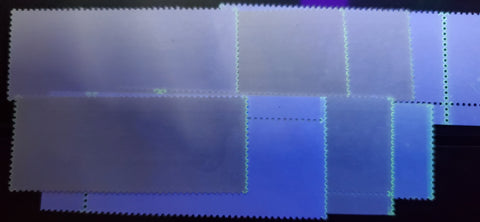
As you can see, there is quite a range on the back as well, with the bottom centre stamp appearing slightly brighter on the back as compared to the front, and the upper right stamp also appearing brighter on the back. There are also a few stamps that appear quite dull as well.
The early Rolland papers in 1986 and 1987 had quite a few instances where the paper was NF/NF or DF/DF, with no fluorescence at all. Later in 1986 and early 1987 we see the full range of front and back reactions, with the very last issues on this paper going back to being mostly DF.
Rolland paper can appear with no fluorescent fibres, or with fairly dense concentrations of LF, MF and HF fibres in the paper. Usually the concentrations will be low to medium density, as opposed to sparse concentrations that we see frequently on the earlier Abitibi papers.
Here are some more examples of differences in the paper as they appear under UV:
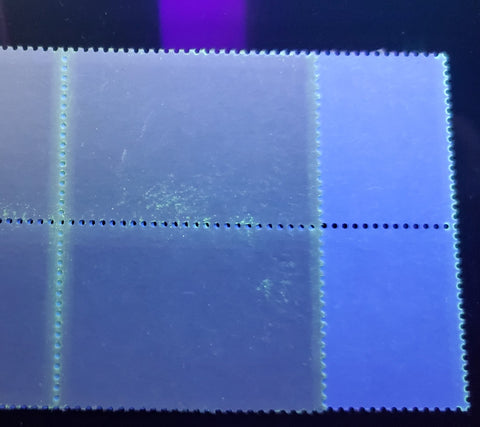
This is the 1987 Explorers issue, and here we see the listed DF and MF papers.
And lastly, some examples from the CBC issue:

Here we see two examples of paper that at first might be mistaken for HB, because of how bright they are, but they are closest to the listed MF paper. There is a true hibrite paper that is brighter than this. Part of the problem with classifying these is that Unitrade does not list all the types that exist, so you wind up trying to match your stamps to their listings, when your stamp might be something entirely different.
Slater Paper
Slater paper at first appears to have no variation at all. It is a creamy paper that is quite pliable. When you examine the printing surface under a loupe, you can see all kinds of little divots in the surface. The gum varies quite considerably in sheen, but on the earlier paper it is thick and creamy with a satin sheen. Later, it becomes thinner and takes on a duller eggshell sheen.
What is interesting though is that the coating on this paper can be found horizontally ribbed, vertically ribbed, or smooth. I do not yet know whether most issues on this paper can be found all three ways or not, but some definitely can.
I first noticed this when examining plate blocks and looking carefully at the selvedge. The ribbing is quite subtle, but clearly visible when you know it is there. It is easiest to see by holding your stamp or block at an angle to a light source and then glancing along the surface. Even without selvedge, you will eventually be able to see the striations in the design, though this takes much more patience to identify. If you examine a ribbed stamp under a loupe you can see the striations are real and not just a figment of your imagination as well. This is one argument in favour of collecting corner blocks or at least singles with selvedge attached, as the selvedge can aid in identifying a variety. Further study will clearly be required to identify which issues exist with which type of ribbing, and which type is scarcer.
In terms of fluorescence, nearly all stamps appear to be on NF/DF or NF/NF paper. The front is generally NF and shows little to no variation. But the backs show very slight variation, being an NF grey and a whiter DF, as shown below:
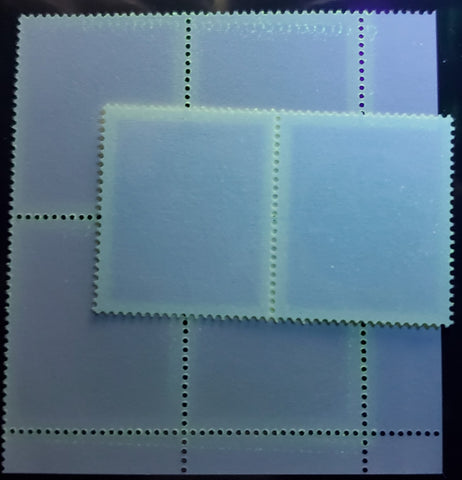
Harrison paper
Early Harrison paper, from 1984 through 1986 tends to be somewhat creamy in colour and has a greenish tinged gum that is often somewhat matte, having a slightly streaky appearance, or a completely smooth and even one. Stamps on Harrison paper have a tendency to curl very severely due to something in the gum that causes it to contract when the stamps have prolonged exposure to air. However in the later part of this period the gum takes on more of a cream colour and does not cause the stamps to curl the way it did in the earlier years. The gum also becomes a bit shinier, and the paper appears more white. It's use is quite limited after 1988, though it continues to be used for certain stamp issues well into the 1990's. The printing surface of Harrison paper is smooth, without the microscopic divots that Slater paper has.
In terms of fluorescence, most Harrison paper is DF/DF, NF/DF or NF/NF. However, on some issues, like the first 1986 Expo '86 issue there are some that appear distinctly LF/DF. The differences between the LF and DF fronts and the DF and NF backs is shown in the pictures below:

Here, if you compare the white portions of the design for both the single and the block underneath it you can see there is a difference that is quite clear.
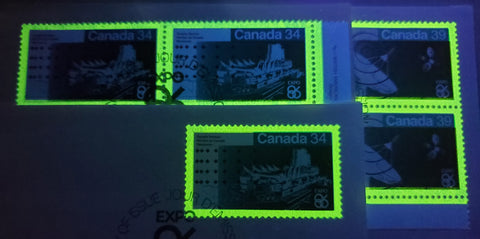
That difference is even more pronounced in the first day cover shown above.
In terms of the appearance from the back, most stamps appear DF. However, there are some that appear a bluish white colour, which is almost bright enough to be LF, but not quite. The picture below shows an example:
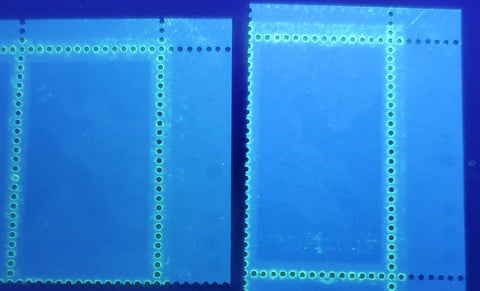
The stamp on the right is clearly brighter than the one on the left, though it is not as bright as stamps that we would normally classify as LF.
Here is another example of the 1986 Explorers issue, but here we have a deeper NF greyish reaction as well, on the top block:
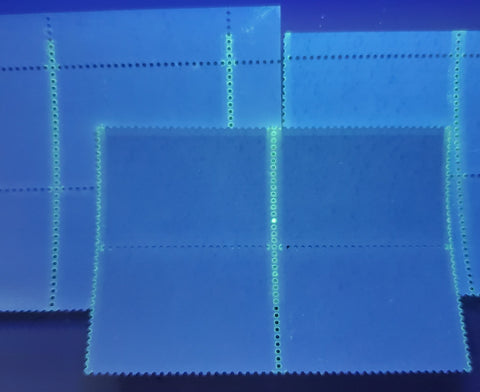
Peterborough Paper
Peterborough paper is very stiff, and it is this stiffness that makes if very distinct from all the other papers. The gum on this paper is colourless and has what I would describe as a satin sheen - smooth and with a very slight gloss - not matte, but not shiny either.
Like Slater paper, the coating on this paper can be ribbed as well. In most cases it is smooth, but where I have come across it ribbed, it has either been horizontally ribbed or cross ribbed, in which the ribbing runs in both directions. This later type I have only seen on the 1990 Norman Bethune issue, but it may exist on the other issues as well. Again, you can see the ribbing in the stamp designs if you know where to look, but it is much easier to see in the selvage of a plate block or single with selvedge attached.
With respect to fluorescence, the early versions of this paper are not fluorescent at all, glowing either a DF or NF bluish white or greyish colour under UV. The early issues printed on this paper, like the 1989 Regiments issue tend to appear somewhat fluorescent in the centre of the stamps only, due to some kind of reaction between the printing inks and the paper. Later, in the early 1990's Peterborough paper starts to exhibit the same range of fluorescence that we saw with many of the Rolland papers, but during this period there are really only two types: DF and NF. The difference between these two is shown below:
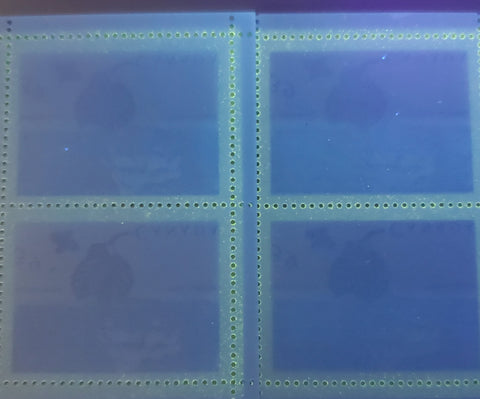
If you look carefully at the left pair you will see that it is brighter and whiter than the pair on the left. The difference is subtle, but distinct if you know what to look for.
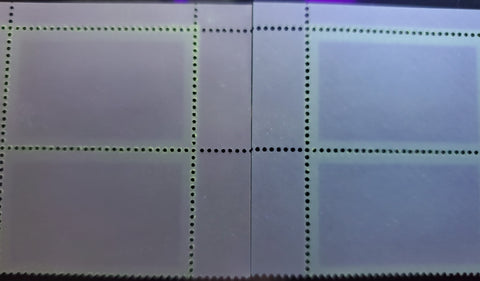
Here is a clear example of NF versus DF Peterborough paper on the 1989 World Trade issue.
The block below illustrates what I was talking about where I said that the printing ink of the vignette can react with the paper to make the centre of the stamp appear more fluorescent than it actually is. These are two blocks from the 1989 Regiments issue.
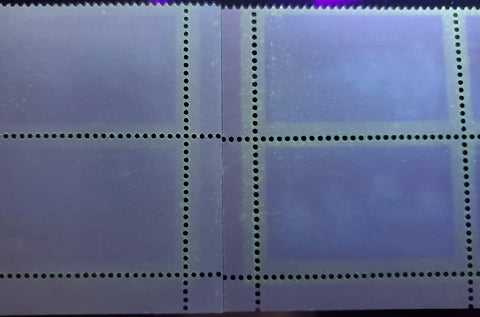
Tagging
The tagging on stamps was changed during this period from GT-2, where the two sides are tagged to GT-4, where the tagging is on all sides of the stamp. However, some stamps, like the 1987 Capex issue below exist with both GT-2 and GT-4 tagging over top of one another. You can only really identify this for sure if you have a stamp with attached selvedge showing the GT-2 bars running all the way up, as in the example below:
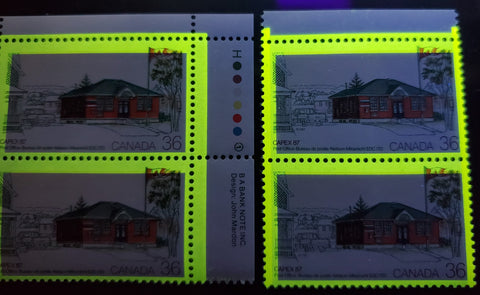
Here you can see that the tagging is much brighter when the stamp is double tagged, but this alone is not sufficient to conclude it is double tagged.
One variation that I have noticed, that is not listed anywhere is that on some stamps the tagging is quite yellowish on the face and shiny, having a lacquer like appearance, while on other stamps is is almost invisible in ordinary light. Then, when you switch on the UV lamp you see this:

The block on the left has the tagging that is almost invisible in normal light. As you can see, under UV it is bright and sharp. On the other block it appears weaker, more washed out and diffuse.
On some blocks and souvenir sheets, some taggant spills or errant tagging mist varieties can be found, such as on the block below:
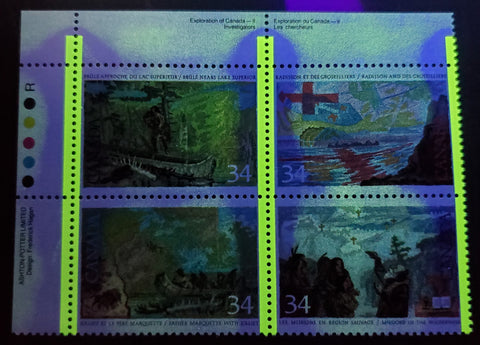
On other blocks you can come across tagging smears like this:
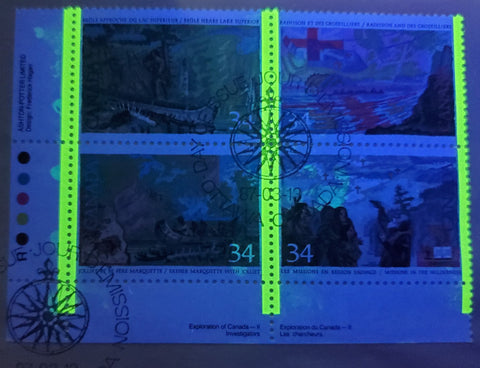
Finally, on some issues there are constant tagging flaws that occur every few sheets. The only one listed right now is on the 1988 Calgary Olympics Alpine Skiing stamp. This flaw is shown below:

This variety, while constant, is tertiary, in that it does not occur on every sheet, as we have seen sheets that do not show the variety.
Based on this observation, it is indeed possible that other such varieties could exist on other issues. Below is one such example:
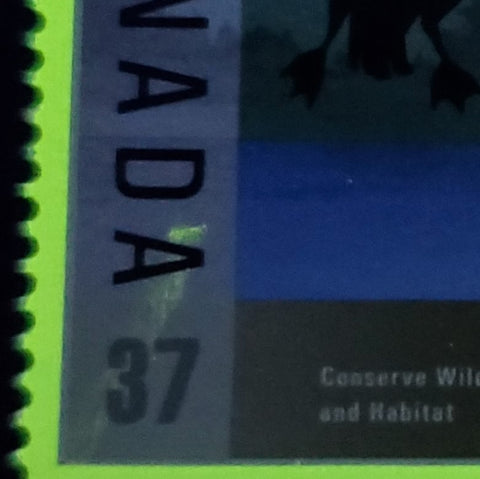
Unlisted Constant Plate Varieties
The only constant varieties listed that I am aware of are the Blue Icicle on the 1988 Dogs issue, the Cufflink and Feather in Cap varieties on the 1988 Les Forges issue, and the Feather in Hat variety on the Frances Ann Hopkins issue, also from 1988.
However, Jim Watt showed me three other varieties on the 1988 Dogs issue, of which two are shown below:
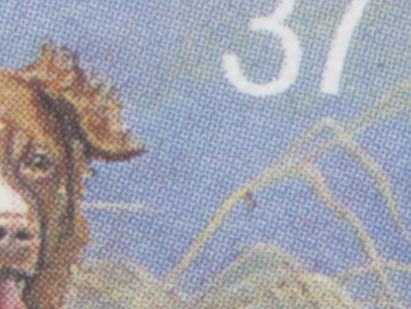
This is the insect in the grass variety that appears on position 30 of some sheets.
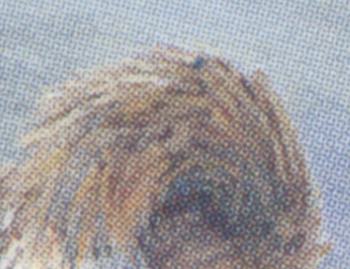
Here is the Flea on Tail Variety that appears on position 3 of some sheets also.
Potentially Constant Varieties
Below are some varieties that I have found, which may or may not be constant. Further study will be required to establish their status:

Worm above mushroom on the 1989 Mushrooms issue.
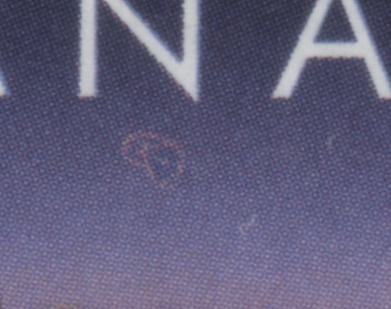
This is the "bursting shell in sky" on the 1989 Regiments issue.

This is the "dot below A and line in D" on the 39c Christmas stamp from 1989.

Here is a bug or apostrophe flaw between the D and A of Canada on another 39c Christmas stamp. This one may be more of a donut flaw, which tends not to be constant, but you never know, as a few donut like flaws actually are constant.
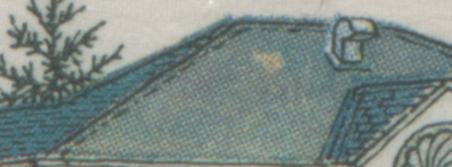
Here we have the missing shingles on the roof of the 42c 1987 CAPEX issue.
Fluorescent Inks
Some stamps from the 1986 Locomotives issue can be found with the purple portion of the locomotive on the 68c value giving a distinct fluorescent reaction under UV light. This opens up the possibility that similar types of inks may exist on the other issues as well.
First Day Covers
Of course there are the first day covers also that can be collected. Most all of these will be Canada post official covers, but you can also still find a few private cachet covers from this period, though they are not common.
In addition to the different configurations of stamps and blocks that can be collected on the covers, it is possible to find variations in the fluorescence of the envelopes as shown below:

Many might think such a difference should not be collectible, but I say why not? If these are an official Canada Post product, then to my way of thinking, the envelope is but one component of the product in the exact same was as tagging or gum are to an actual stamp.
Conclusion and Final Collecting Advice
So here you have it. You can see that there is much more to these issues than first meets the eye. But the question remains: how can you identify everything that exists and acquire it? My advice is to start seeking out any printings you can find that are on field stock. The reason is that most issues usually have an initial philatelic printing that is distributed to the Philatelic Department in Antigonish, and then all subsequent printings are on field stock, and get sent to post offices without any mention of their existence ever being made. Lessons learned from the past with the 1972-78 Caricatures, in which most all of the better varieties were on field stock, illustrates the importance of beginning here, if you want to identify unlisted paper and tagging varieties.
A second tip is to look very carefully at any full sheet that you come across. Don't assume that there are no varieties, but take the tame to look at every stamp. If you do this diligently I am confident that you will find other constant varieties. Dr. Jim Watt once told me that if you find a variety on philatelic and field stock that this proves it is constant, and that such a variety can exist on a first day cover as well.

